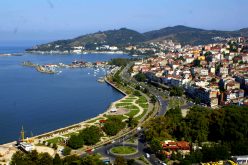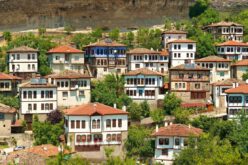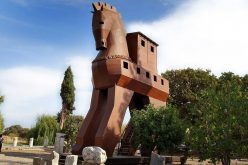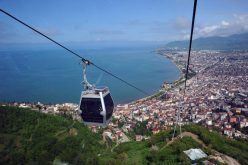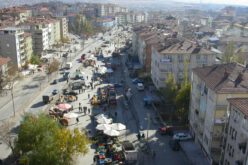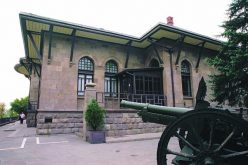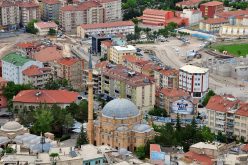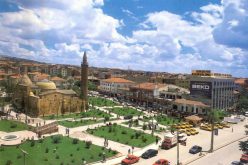Mardin
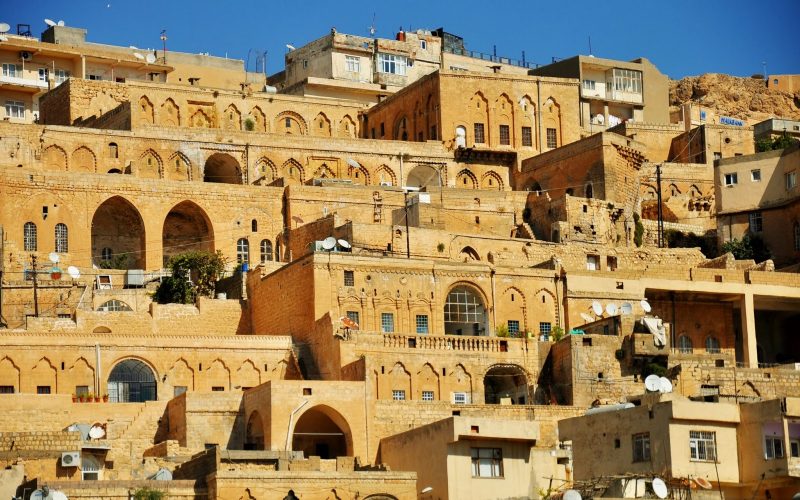
Mardin
Mardin is a historical city in Southeastern Anatolia, Turkey. A city situated on the top of a hill, it is known for its fascinating architecture consisting of heavily decorated stonework cascading from the hilltop and used to be an important center of the Western Asia for both its strategic location and commercial richness.
Mardin was once a very important center for Christianity. Architectural structures belonging to different epochs have reached out time in a unique architectural integrity. One can find unique Mardin houses; churches of Kırklar, Mar Mihail, Behrimiz, Virgin Mary, Mar Yusuf and Mar Bitris; medresses of Kasımiye, Zinciriye and Marufiye; monasteries of Deyr’ul Zafaran and Deyr’ul Umur; mosques of Ulu, Çubuk and Molla Hari and the castle as important buildings in this integrity. The population of the province is 705,098 (Census of 2000). Dargeçit, Derik, Kiziltepe, Mazidagi, Midyat, Nusaybin, Ömerli, Savur and Yesilli are Mardin’s districts in the periphery. The culture of Mardin bears the imprint of various antique civilizations flourishing in the area. Mardin has an enormous historical, cultural and architectural richness. It is apparent that this richness has the potential of contributing much to the development of the province and national tourism if mobilized and managed properly. Mardin enjoys a privileged status in the sense that it is able to make people live the past and to present what is old and valuable to present generations. Mardin’s cultural diversity is further enriched by the deep-rooted culture of various communities including the oldest Christian community, the Suryani. Who can refuse to see a city of tolerance where ezan from mosques lives in brotherhood with church bells? In recent years Mardin has become a center of attraction for many people from different parts of the world. It is a candidate for UNESCO’s List of ‘Cities of World Heritage.’ Submitting, protecting and transferring cultural richness for the next generations require a big importance.
In our city and its provinces we have 665 buildings registered by protection of culture and nature values committee directorate.
Places to Visit;
Ancient Cities Midyat city is a museum city like Mardin, is approximately 1.5 hours away from Mardin. Midyat, where, rock mansions, gates with arches, Süryani churches with minaret like ascending gong towers, is reminding a Medieval city.
City center is moved to 2 km. away Estel with slowly leaving the region of Süryanis and emigration. Most beautiful samples of masonry, known as Telkari were in Midyat. A few telkari masters are trying to continue their job within Midyat bazaar. You should absolutely see…. This very important province of Mardin is also famous with silver smiting. Province, which is an important place in connection with handicrafts is also attractive related with tourism.
Deyrulumur Monastery, which is 18 km. east of the province is constructed in 397 A. D. On 640 A. D. during Hz. Ömer, when Arabic Islam army cooperates with Süryanis, and enter into Mesopotamia, for especially preservation of this piece of arts a privilege is given to it by Hz. Ömer’s order. There were a rich library within the monastery formerly. There were also a theology church, in which thousands of students were educating. Products such as Oak, Bitim, Pistachio and unique Russian cucumber and melon is cultivated in Midyat. It is a junction point, where most quality grapes of the world are cultivated.
The province, which is a part of Upper Mesopotamia, is founded in Tur-Abidin (Turabdin) Region. Midyat, is known as “Matiate”, which means cavern city in 9th century B. C. Asur Tablets. Probably its name is coming from this. Midyat, which is 1,5 hour away from Mardin, shows the similar climate characteristics as Mardin. Summers are very hot and dry, and winters are rainy and cold in Midyat, which has the characteristics of both Mediterranean climate and terrestrial climate.
Dara City Ruins. This ancient city is located at 30 km. away from the southeast of Mardin province in Oğuz village. This city is the most famous city of the ancient Mesopotamia region. The ruins of Dara city is spread over a vast area which could extent to 8 – 10 km. and there are houses carved into rocks and founded in caves. The church, palace, bazaar and storage yards, dungeon and the water dam are still visual among the ruins of the city. There are also 6 – 7 cave houses around the village. The history of this caves extend to the Late Roman (Early Byzantine) period.
Castles
Mardin Castle: This castle was constructed by Hamdani nation in AD 975 – 976 years. There is a mosque, bath, dungeon and numerous warehouses inside the castle.
Dara Castle: The castle is located 30 km. away from Mardin province. The castle was constructed by the monarch of İran. Mosques Cevat Paşa Mosque was constructed in 1915. It has tick walls and its type is a mosque with courtyard. At the middle of the mosque there is a small dome. Its minaret is made up of Midyat rock, and has cylindrical shape. It has two minaret balconies, and decorated with vegetable and geometrical shapes.
Ulu Mosque. Three sides of the niche, constructed in 1800 are decorated with vegetable adornments. Its minaret has single minaret balcony. H. Abdurrahman Mosque’s construction date is in 1915 (H.1331) Mosque has one minaret. There is only one balcony on its minaret. Monasterıes Deyr-Ül Umur Monastery, also known as Mar Gabriel, is established on a hill with laying its foundations on 379, near Midyat. There are temples, known as Meryamana, Resüller, Kırk Şehit, Mar Şumuel, Mar Şemun, accommodation and worship places of priests, tomb and graveyard within Monastery. Mar Gabriel is also used for Bishop center by Süryani Church. Mar Gabrıel Monastery (Deyrul Umur), which is also the center for metropolis of Turabidin region, is approximately 22 km. away from Midyat, at 2 km. north of Yayvan hill bay, on a low hill, and established by Mar Samuel in 397. In this monastery, which is one of the oldest and activating Christian monastery, Meryem Ana Church, Kırk Şehitler Church, Kartminli Smuel Church, Thedora dome with eight arches and Mısırlılar dome is present.
Churches
Mort Smuni Church is an ancient church, built in tenth century. It is also used as Metropolis center. The exchange of Bairam greetings is performed within this church. Mor Barsavmo Church’s foundation is laid in the 4th century. It is re – constructed over this foundation.
Mor Aksanoya Church is the oldest church within province center. It is constructed on idolaters’ temple during the 4th century. This church, which is restored with benefiting from the old ruins in 1961, is at the south east outside the province.
Mor Sarbel Church, which is at the center of the province, is one of the most impressive churches.
Protestant Church is constructed at the beginning of 1900s. Meryem Ana (Virgin Mary) Church .This ancient church, which has no bastion, belongs to Catholic community.
Mor Abraham Church is established by two monks from Mar Gabriel on Vth century. Central graveyard of Midyat Christians is here. There is a Meryem Ana dome in this monastery.
Meryem Ana Church (Within Anıtlı Village), which is in the Anıtlı village, has a rare architectural characteristic, which can’t be seen today. Hah Cathedral (Mar Sobo Church). Ruins of this cathedral devoted to Mar Sobo during the 6th century are important historical pieces of arts. Hah Ruins. There is no written source related with ruins between Anıtlı and Karagöl, and they have the signs of a big civilization.
Religious Monuments As Mardin Province is an important center of Religion Tourism, the important religious structures in the Mardin city center could be counted as; Ulu Mosque, Meryem Ana Church (Mother Marian) and Patriarchate, Mor Yusuf Church (Surp Hovsep), Deyruülzzafaran Monastery (Mor Hananya), Deyrulumur Monastery (Mor Gabriyel), Mor Yakup Monastery (Nusaybin), Midyat Meryemana Monastery and Mor Dimet Monastery. Caves Mardin Gızzelin Cave (Threat Weaving), Midyat Linveyri Cure Cave , Mardin Şakolin and Firiye, Midyat Kefilsannur, Midyat Şenköy Kefilmelep, Kefilmardin, Midyat Hapisnas, Midyat Tınat, Savur Kıllıt, Kızıltepe Hanika and Salah, Nusaybin Hessinmeryem and Sercahan, Mazıdağı Gümüşyuva and Avrıhan, Derik Derinsu, Dırkıp, Haramiye Caves are the caves inside the borders of Mardin. Museums It is in Mardin Center, on 1st Street of Cumhuriyet Avenue, beside Atatürk sculpture. In accordance with the inscription on the closed portal of Mother Mary Church looking to the museum, the building has been constructed by Antakya patriarch İgnatios Behnam Banni as Syrian catholic patriarchate. Later, it has been used as military garrison, M.S.P provincial organization, cooperative building, health center and police station. Ministry of Culture has purchased the building from Syrian Catholic Foundation, has decided to restore this building in 1988 and has opened it as a museum in 1995. Until that time, the old museum acted in Zinciriye Madrasa that has been constructed by Sultan İsa, who is one of Artuklu sultans.
The new museum building is completely made of cut limestone. There are unique ornaments on the internal and external vaults, arches, rails and column heads. The museum has three floors: On the first floor there are reception, conference, exhibition and resting halls. On the second floor there are ethnography exhibition hall, library and work warehouses and on the third floor there are halls where some works obtained from Girnevas Tumulus excavation and archeological works provided to the museum by purchase are exhibited and administrative sections are located. The works in the museum are works belonging to the period in between 4000 BC and 7th century BC. In the archeological halls, slabs, cylindrical and stamp seals, cult pots, figurines, metal awls, jewelry, ceramics, golden, silver and copper coins, tear bottles and candles belonging to the Old Bronze, Asyrrian, Urartu, Greek, Persian, Hellenistic, Roman, Byzantine, Grand Seljuk, Artuklu and Ottoman periods are exhibited. In the ethnography hall, necklaces, earrings, bracelets, anklets, diadems, hair jewelry, which are elite samples of silver ornamenting special to Mardin and its surroundings, especially to Midyat District and besides them old clothes, swords, coffee (mırra) sets, bath goods, prayer beads, heating tools and copper goods are exhibited.
Write a Comment
Only registered users can comment.




